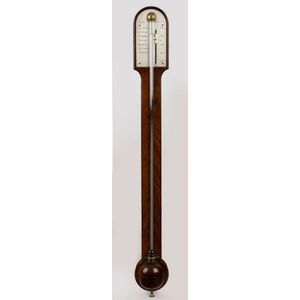Georgian Mahogany Stick Barometer by Bate, London, 19th Century
A Georgian mahogany round topped stick barometer with hemispherical cistern cover and chevron veneered case, by Bate of London, early 19th century, 55 cm high
You must be a subscriber, and be logged in to view price and dealer details.
Subscribe Now to view actual auction price for this item
When you subscribe, you have the option of setting the currency in which to display prices to $Au, $US, $NZ or Stg.
This item has been sold, and the description, image and price are for reference purposes only.
- Mahogany - Mahogany is a dense, close grained red-coloured timber from the West Indies and Central America. It was first imported into Europe in the the early 18th century and its use continued through the 19th century. It was popular for furniture making because of its strength, the wide boards available, the distinctive grain on some boards, termed flame mahogany and the rich warm colour of the timber when it was polished.. The "flame" was produced where a limb grew out from the trunk of the tree, and this timber was usually sliced into veneers for feature panels on doors, backs and cornices.
Some terms used to describe mahogany relate to the country from which it originally came, such as "Cuban" mahogany, "Honduras" mahogany etc. However unless the wood has been tested the names assigned are more a selling feature, rather than a true indication of the timber's origin. - Chevron Motif - In jewellery, a chevron is a V-shaped pattern or design that is often used to create a bold and striking visual effect, and as a symbol of strength, power and protection.. It is a classic motif used in many different styles of jewellery and can be seen in various forms such as on a ring, earrings, bracelets, and necklaces. It can be created with precious or semi-precious stones, pearls, or enamel. It can be found in different forms such as engraved or inlaid or beaded.
In ceramics the pattern is often used in decorative pottery and porcelain pieces, such as vases, bowls, plates and figurines. The chevron pattern can be created by using different colored glazes or by hand-painting the design onto the piece. It is also commonly found in the form of embossing or intaglio in decorative ceramic objects. This pattern can be seen as a popular design choice in Art Deco and Art Nouveau style of ceramics.
This chevron pattern can also be found in many different types of furniture, such as tables, chairs, chests of drawers, and cabinets. A common place to find chevron pattern is in a herringbone pattern, which is made up of repeating V-shaped patterns. The chevron pattern can be created by using different types of wood, inlaying or by using different colors of stain. It is also commonly found in the form of a veneer. This pattern can be seen as a popular design choice in mid-century modern, Art Deco, and contemporary style furniture. - Georgian - As an English stylistic period, Georgian is usually taken to cover the period from George I (1714) to the Regency of Prince George (1811-20), although the period from 1800 to 1830 is sometimes designated as the Regency period. During the Georgian period the great English cabinetmakers and designers such as Chippendale, Hepplewhite, Adam Sheraton etc., were all active.
Therefore there isn't a single 'Georgian style' as such and to say something is 'Georgian', usually means it was made between 1714 and 1830. This assumes we discount George V and George VI, both being from the 20th century.
The styles popular at the time of each reign were:
George I (1714-1727) saw out the last years of the Baroque period.
George II (1727-1760) reigned during the Rococo period.
George III (1760-1820) saw the last gasp of the Rococo, all of the early Neo-Classic 'Adam style' and most of the later neo-Classic 'Regency style'.
George IV (Prince Regent 1820-1830)encompassed the last of the 'Regency' style.
William IV's reign (1830-1837) was something of a no man's land (stylistically) and he wasn't a 'George' anyway. He covered the last glimmerings of 'Regency' and the start of the 'Victorian' style.
This item has been included into following indexes:
